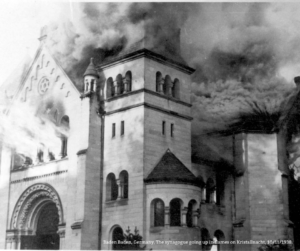The Kristallnacht Pogrom marked a devastating turning point during the  Holocaust: a shift from antisemitic propaganda and policy to government-sanctioned violence against Jewish communities in Germany, annexed Austria, and in areas of Czechoslovakia that had been recently occupied by German troops. The anniversary of this event on November 9 and 10 presents an opportunity for educators to explore this history with students—to teach about the dangers of antisemitism and the role and responsibility of an individual in interrupting the escalation of hate. Furthermore, the lessons of the Kristallnacht Pogrom, only further highlight the importance of our collective duty to uphold the pillars of democracy. At a time when our nation is facing increasingly high levels of antisemitism, the lessons from the “Night of Broken Glass” can resonate deeply with students and compel them to examine the critical need to stand up to antisemitism and all forms of hate. Here are some strategies and resources to guide you in teaching this topic:
Holocaust: a shift from antisemitic propaganda and policy to government-sanctioned violence against Jewish communities in Germany, annexed Austria, and in areas of Czechoslovakia that had been recently occupied by German troops. The anniversary of this event on November 9 and 10 presents an opportunity for educators to explore this history with students—to teach about the dangers of antisemitism and the role and responsibility of an individual in interrupting the escalation of hate. Furthermore, the lessons of the Kristallnacht Pogrom, only further highlight the importance of our collective duty to uphold the pillars of democracy. At a time when our nation is facing increasingly high levels of antisemitism, the lessons from the “Night of Broken Glass” can resonate deeply with students and compel them to examine the critical need to stand up to antisemitism and all forms of hate. Here are some strategies and resources to guide you in teaching this topic:
Explore Personal Narratives
Those who experienced the horrors of the Kristallnacht Pogrom provide powerful insights into the impact of the choices and decisions made in the face of the growing hatred and violence that surrounded them. As a teenager, Holocaust survivor Kurt Messerschmidt witnessed mobs attacking Jews in the street, in their homes, and at their places of worship, while many of his German neighbors and friends stood idly by. His testimony offers an important and inspirational message for students:
“SOME OF THE PEOPLE DISAPPROVED, BUT THEIR DISAPPROVAL WAS ONLY SILENCE.”
Have students reflect on this powerful statement and learn more about Kurt Messerchmidt:
- Watch Kurt’s video testimony clip to examine the ramifications of remaining silent in the face of hate.
- Engage students with USC Shoah Foundation’s IWitness activity about Kurt to learn more about his experience during the Holocaust.
- Download our Inspiring the Human Story poster series and accompanying activities, featuring Kurt and other important figures from the Holocaust.
Additionally, the testimony of survivor Esther Clifford, also impacted by the devastation of the Kristallnacht Pogrom, can help students understand the human story behind this event and consider the consequences of not standing up to injustice.
Use Primary Sources
A key component of our Echoes & Reflections pedagogy is to enrich students’ understanding of the Holocaust by providing an abundance of print and digital resources from a variety of perspectives. An examination of historical documentation can aid students to further contextualize and gain a deeper understanding of the Kristallnacht Pogrom:
- Access our lesson plan, Kristallnacht: “Night of Broken Glass”, and Unit on Nazi Germany for tools and approaches for incorporating primary sources into your instruction.
- Read our blog written by an Echoes & Reflections teacher who offers suggestions for using primary sources to connect students to the lessons of the Kristallnacht Pogrom.
- Take a virtual field trip with students to Yad Vashem – The World Holocaust Remembrance Center to explore primary sources from the Kristallnacht Pogrom featured in their online exhibition.
Teach with a Timeline:
Timelines can serve as a visual tool for studying periods of history and help students realize not only how events happened, but how to construct meaning and illuminate the human experience throughout a past era. This resource can also encourage students to see connections between events occurring in a single period and bring history to life by mapping dates onto a cohesive narrative. On our interactive Timeline of the Holocaust with accompanying activities, teachers can introduce the Kristallnacht Pogrom, as well as the dates prior to and immediately following this pivotal incident, which can allow students to grasp that the Holocaust was a progression of decisions, actions, and inactions, any of which might have happened differently if alternative choices were made.
Teaching about the Kristallnacht Pogrom is a crucial component of Holocaust education as it can reinforce students’ understanding of what ultimately led to the extermination of Europe’s six million Jews by the Nazis, underscoring the notion that the Holocaust was not inevitable.



